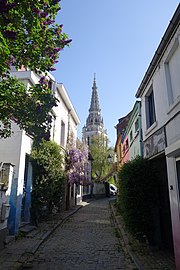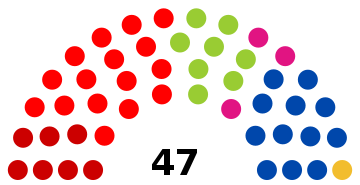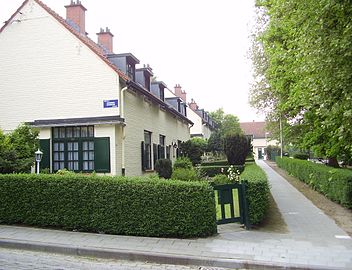Anderlecht
show This article may be expanded with text translated from the corresponding article in French. (August 2016) Click [show] for important translation instructions. |
Anderlecht | |
|---|---|
 The Place de la Vaillance in Anderlecht | |
 Flag  Coat of arms | |
 Anderlecht Location in Belgium
show Anderlecht municipality in the Brussels-Capital Region | |
| Coordinates: 50°50′N 04°20′E / 50.833°N 4.333°ECoordinates: 50°50′N 04°20′E / 50.833°N 4.333°E | |
| Country | Belgium |
| Community | Flemish Community French Community |
| Region | Brussels |
| Arrondissement | Brussels |
| Government | |
| • Mayor | () |
| • Governing party/ies | PS - sp.a - cdH - Ecolo - Groen - DéFI |
| Area | |
| • Total | 17.74 km2 (6.85 sq mi) |
| Population (2018-01-01)[1] | |
| • Total | 118,382 |
| • Density | 6,700/km2 (17,000/sq mi) |
| Postal codes | 1070 |
| Area codes | 02 |
| Website | www.anderlecht.be |
Anderlecht (French: [ɑ̃dɛʁlɛkt], Dutch: [ˈɑndərlɛxt] (![]() listen)) is one of the 19 municipalities of the Brussels-Capital Region, Belgium. Located in the south-western part of the region, it is bordered by the City of Brussels, Forest, Molenbeek-Saint-Jean, and Saint-Gilles, as well as the Flemish municipalities of Dilbeek and Sint-Pieters-Leeuw. In common with all of Brussels' municipalities, it is legally bilingual (French–Dutch).
listen)) is one of the 19 municipalities of the Brussels-Capital Region, Belgium. Located in the south-western part of the region, it is bordered by the City of Brussels, Forest, Molenbeek-Saint-Jean, and Saint-Gilles, as well as the Flemish municipalities of Dilbeek and Sint-Pieters-Leeuw. In common with all of Brussels' municipalities, it is legally bilingual (French–Dutch).
There are several historically and architecturally distinct districts within Anderlecht. As of 1 February 2015, the municipality had a population of around 118,414.[2] The total area is 17.74 km2 (6.85 sq mi), which gives a population density of 6,610/km2 (17,100/sq mi). Its upper area is greener and less densely populated.
History[]
Origins and medieval times[]
The first traces of human activity on the right bank of the Senne date from the Stone Age and Bronze Age. The remnants of a Roman villa and of a Frankish necropolis were also found on the territory of Anderlecht. The first mention of the name Anderlecht, however, dates only from 1047 under the forms Anrelech, then Andrelet (1111), Andreler (1148), and Anderlech (1186). At that time, this community was already home to a chapter of canons and to two feudal manors, those of the powerful lords of Aa and of Anderlecht.
In 1356, Louis of Male, Count of Flanders, fought against Brussels on the territory of Anderlecht, in the so-called Battle of Scheut, supposedly over a monetary matter. Although he defeated his sister-in-law, Joanna, Duchess of Brabant, and briefly took her title, she regained it the following year with the help of Charles IV, Holy Roman Emperor. In 1393, Joanna's charter made Anderlecht a part of Brussels. It is also around this time that the church of Saint Guy was rebuilt above the earlier Romanesque crypt in the Brabantian Gothic style.
15th–18th centuries[]
The city of Anderlecht became a beacon of culture in the 15th and 16th centuries. In 1521, Erasmus lived in the canons' house for a few months. Charles, Duke of Aumale and Grand Veneur of France also had a residence here.
The 17th and 18th centuries were marked by the wars between the Low Countries and France. On 13 November 1792, right after the Battle of Jemappes, General Dumouriez and the French Revolutionary army routed the Austrians here once again. Among the consequences were the disbanding of the canons and Anderlecht being proclaimed an independent municipality by the French.
19th century and later[]

The 19th century saw a remarkable population growth, mainly because of the proximity to a rapidly expanding Brussels. Remarkable new urban developments and garden cities such as La Roue/Het Rad, Moortebeek and Bon Air/Goede Lucht were built at the beginning of the 20th century to house the influx of newcomers. Today, the name Anderlecht rings a bell in every Belgian ear thanks to its very successful football club.
Districts[]
Historical centre[]
The historical centre of Anderlecht is the municipality's central district. Formerly known as Rinck, it is divided into several sectors: the Saint-Guidon/Sint Guido district, also called the Vaillance (Dutch: Dapperheid) district, is the meeting point for those who hail to the heart of Anderlecht. It is also where the Place de la Vaillance/Dapperheidsplein with its Collegiate Church, the Place de Linde/De Linde Plein, as well as Anderlecht's main schools are located. Rue Wayez/Wayezstraat is the municipality's main shopping street. It is centred on the Place of the Resistance/Verzetsplein and some neighbouring streets. The Aumale district mainly comprises Rue d'Aumale/Aumalestraat and its surrounding streets. It includes Erasmus House, the old beguinage and the Bibliothèque de l'Espace Maurice Carême public French-speaking library.
Cureghem/Kuregem[]
Located in the east of Anderlecht, the Cureghem (Dutch: Kuregem) district is one of the municipality's largest and most populated neighbourhoods. It developed during the Industrial Revolution along the Brussels–Charleroi Canal and is currently in a fragile social and economic situation due to the decline of its economy and the poor quality of some of its housing. Between 1836 and 1991, the district housed the Royal School of Veterinary Medicine, now moved to Liège but often still referred to as 'Cureghem'. The old campus, listed as protected heritage, is currently facing a large process of rehabilitation.
Three listed buildings; the former Atlas Brewery, the old power station and the former Moulart Mill are testaments to the old industrial activities next to the waterway. The Town Hall of Anderlecht is located on the Place du Conseil/Raadsplein, at the heart of this district.
La Roue/Het Rad[]
Located in the south of Anderlecht, the La Roue (Dutch: Het Rad) district is one of the municipality's largest districts and one of the main garden cities of the Brussels region. Built in the 1920s, with its modest and picturesque houses, it offers a great vision of an early 20th century working class neighbourhood. It is also home to one of the largest agribusiness industry campuses in Belgium, the Food and Chemical Industries Education and Research Center (CERIA/COOVI), and other popular department stores.
Sights[]
- The Collegiate Church of St. Peter and St. Guido is located in the municipality's historical centre, on the northern side of the Place de la Vaillance/Dapperheidsplein, its main square. It contains the grave of the 11th century saint Guy of Anderlecht. Its Romanesque crypt dates from the 10th century and is one of the oldest in Belgium. Most of the church, however, dates from 1350 and later, with most of the currently visible architecture representing the Ogee style (15th–16th centuries). Construction of the tower started in 1517 but stopped with the square part up to the balcony, and was not completed until 1898.[3]
- Right next to the church, the old beguinage is home to a local historical museum.
- Erasmus House, built in 1458, and its medicinal and philosophical gardens can be visited nearby.
- The National Museum of the Resistance, which traces the history of the Belgian resistance and German occupation of Belgium during World War II
- The Museum of China – Scheut, which houses documents and pieces brought back to Europe by the congregation of Scheut's missionaries, including a 15th-century bronze Buddha[4]
- The Maurice Carême Museum, in the Maison blanche where the Belgian poet lived and wrote[5]
- The Luizenmolen, a replica of an old windmill which once stood on the site[6]
- Anderlecht is the location of the Cureghem Cellars (French: Caves de Cureghem, Dutch: Kelders van Kuregem), a subterranean complex of handmade brick caves with Romanesque vaults, pillars, and arches, originally the site of a cattle market covered by a forged-iron roof construction in the 1890s.[7] The cellars were simply a foundation for the upper structure until the 1930s, after which the city council decided to make better use of them. It proved more profitable to grow mushrooms in the dark and damp underground spaces for local consumption. It fell into disuse as a cattle market but, in 1984, the hall officially got listed as a Belgian monument. Due to its characteristic architecture and unique layout it was refurbished and transformed by a private company, Abattoir SA. Since 1992, it serves as an attractive and functional event site for various private, corporate or public occasions and events. One of these was the anatomic exposition Body Worlds (German: Körperwelten) by Dr. Gunther Von Hagens, which ran in the cellars between 2008 and 2009 and attracted over 500,000 visitors.
- Anderlecht also houses the Cantillon Brewery, a gueuze museum established in an actual working brewery.
- The Museum of Medicine, located on the Erasmus campus of the Université libre de Bruxelles[8]
- The Jean-Claude Van Damme statue located on Boulevard Sylvain Dupuis/Sylvain Dupuislaan, near the Westland Shopping Center

Beguinage of Anderlecht
Moortebeek Garden City

Porselein Street
Justice de Paix of Anderlecht
Demographics[]
Migrant communities in Anderlecht with over 1,000 people as of 1 January 2020:[9]
| 7,405 | |
| 4,924 | |
| 2,985 | |
| 2,743 | |
| 2,727 | |
| 2,628 | |
| 2,549 | |
| 1,717 |
Politics[]
The current city council was elected in the October 2018 elections.[10] The current mayor of Anderlecht is , a member of PS, who alongside the other parties on their list, sp.a and cdH, is in coalition on the municipal council with Ecolo - Groen, DéFI and Forward.[11]
 | ||||||||||
| Party | ||||||||||
|---|---|---|---|---|---|---|---|---|---|---|
| Votes | % | Swing (pp) | Elected 2018 |
Change | ||||||
| PS - sp.a - cdH | 14,023 | 29.73 | 16 / 47 (34%)
|
|||||||
| MR - Open Vld - IC | 10,628 | 22.53 | 12 / 47 (26%)
|
|||||||
| Ecolo - Groen | 7,320 | 15.52 | 8 / 47 (17%)
|
|||||||
| PVDA-PTB | 6,891 | 14.61 | 7 / 47 (15%)
|
|||||||
| DéFI | 3,581 | 7.59 | 3 / 47 (6%)
|
|||||||
| N-VA | 1,950 | 4.13 | 1 / 47 (2%)
|
|||||||
| VB | 1,006 | 2.13 | 0 / 47 (0%)
|
|||||||
| CD&V Plus | 716 | 1.52 | New | 0 / 47 (0%)
|
- | |||||
| Others | 1,059 | 2.25 | New | 0 / 47 (0%)
|
- | |||||
Events[]
The annual Anderlecht fair, originally a cattle fair, was authorised by William II of the Netherlands in 1825. Since then, it has taken the form of a series of celebrations, which still include animal shows but also a large market, a floral show, and the recreation of a religious procession in honour of Saint Guy.
Economy[]

The Abattoirs of Anderlecht, located at 24, Rue Ropsy Chaudron/Ropsy Chaudronstraat in Cureghem, is the main slaughterhouse in Brussels, employing some 1,500 people. In addition to its main activities, the great hall serves as a covered market for food and flea markets.[12]
In recent years, several major international companies have set up their headquarters in Anderlecht, notably the Delhaize Group, which operates many supermarket chains, from 40, Marie Curie Square,[13] Coca-Cola Benelux at 1424, Chaussée de Mons/Bergensesteenweg,[14] as well as the Belgian chocolate company Leonidas at 41, Boulevard Jules Graindor/Jules Graindorlaan.[15]
Healthcare[]
Several hospitals and clinics are located in Anderlecht:
- Erasmus Hospital
- Joseph Bracops Hospital[16]
- St. Anne St. Remigius Clinic[17]
Sports[]

Football[]
Anderlecht is the home of the football club RSC Anderlecht, the most successful Belgian football team in European competition as well as in the Belgian First Division with 34 titles.[18] The club's home stadium is the Lotto Park, located within Astrid Park. The team colors are white and purple.
Parks and green spaces[]
Green spaces in the commune include:[19]
- Astrid Park
- Parc Forestier/Bospark, in Scheut
- Scherdemael Park
- Peterbos Park
- Joseph Lemaire Park
- Jean Vives Park
- Parc des Étangs/Vijverspark, in Neerpede
- Parc de la Rosée/Dauwpark, in Cureghem
- The Vogelzang or Vogelenzang, a natural protected area
Famous inhabitants[]

- Guy of Anderlecht (c. 950–1012), known as the Poor Man of Anderlecht, patron saint of Anderlecht[20]
- Adrian VI (1459–1523), pope, theologian, rector at the University of Leuven, canon at the Chapter of Anderlecht, lived in Anderlecht.
- Joseph Bracops (1900–1966), politician and mayor
- Jacques Brel, singer. He lived from 1942 to 1951 at 7, Rue Jacques Manne/Jacques Mannestraat, and worked from 1946 to 1953 in the family cartonery Vanneste & Brel (now SCA Packaging) at 18, Rue Verheyden/Verheydenstraat. A metro station, located in the municipality, is named after him.
- Maurice Carême (1899–1978), poet
- Fernand Dineur (1904–1956), cartoonist
- Desiderius Erasmus (1466–1536), humanist and theologian
- Désiré Keteleer (1920–1970), cyclist
- Filip Peeters (b. 1962), Flemish actor
- Germaine Schneider (1903–1945), Belgian-Swiss resistance fighter
- Henri Seroka (b. 1949), composer
- Henri Simonet (1931–1996), politician and mayor
- Jacques Simonet (1963–2007), politician and mayor
- Philippe Thys (1889–1971), cyclist and three-time champion of the Tour de France
- Tonia (b. 1947), singer
- Toots Thielemans (1922–2016), jazz musician, lived in Anderlecht.
- William Vance (b. 1935), comic book artist
- Constant Vanden Stock (1914–2008), entrepreneur, footballer and functionary
- Virgile Vandeput (b. 1994), Belgian-born alpine skier who competes for Israel
- Régine Zylberberg (b. 1929), chanson singer, actress and nightclub entrepreneur
Born in Anderlecht:
- Princess Elisabeth, Duchess of Brabant (b. 2001), Duchess of Brabant, the oldest child of the Belgian king Philippe; heiress
- The princes Gabriel and Emmanuel and Princess Eléonore; 2nd, 3rd and 4th in line to the throne of Belgium, were born in Anderlecht.
- Yannick Mertens (b. 1987), tennis
International relations[]
Anderlecht is twinned with:[21]
 Boulogne-Billancourt, France
Boulogne-Billancourt, France Berlin-Neukölln, Germany
Berlin-Neukölln, Germany London Borough of Hammersmith and Fulham, United Kingdom
London Borough of Hammersmith and Fulham, United Kingdom Zaandam, Netherlands
Zaandam, Netherlands Marino, Italy
Marino, Italy
In addition, Anderlecht has signed a friendship agreement with:[21]
 Sainte-Maxime, France
Sainte-Maxime, France
References[]
- ^ "Wettelijke Bevolking per gemeente op 1 januari 2018". Statbel. Retrieved 9 March 2019.
- ^ "Ma commune à la loupe — fr". ibsa.brussels. Retrieved 2019-06-08.
- ^ Eug. De Seyn, "Geschied- en aardrijkskundig woordenboek der Belgische gemeenten" (Historic and Geographic Dictionary of Belgian communes), A. Bieleveld, Brussels 1933-1934.
- ^ Fun, Everything is (2017-03-10). "Museum of China - Scheut". Brussels Museums. Retrieved 2019-12-14.
- ^ "Musée Maurice Carême". www.mauricecareme.be. Retrieved 2019-12-14.
- ^ "Luizenmolen Anderlecht". users.skynet.be. Retrieved 2019-12-14.
- ^ "Kelders van Cureghem/Les Caves de Cureghem/The Cureghem Cellars". Retrieved 2019-12-14.
- ^ Fun, Everything is (2017-03-10). "ULB - Museum of Medicine". Brussels Museums. Retrieved 2019-12-14.
- ^ "Nationalités". ibsa.
- ^ "Résultats officiels des élections communales 2018" (in French). Retrieved 17 July 2021.
- ^ "Anderlecht: l'acte de présentation d'Eric Tomas à la fonction de bourgmestre est signé" (in French). 15 October 2018. Retrieved 17 July 2021.
- ^ "Slaughterhouse". Retrieved 2019-12-14.
- ^ "Contacts Archived 2012-05-22 at the Wayback Machine." Delhaize Group. Retrieved on 16 May 2012. "Square Marie Curie 40 1070 Brussels - Belgium"
- ^ "Contact" (in French). Retrieved 2017-02-17.
- ^ "Leonidas - Bienvenue dans un monde chocolat". www.leonidas.com. Retrieved 2017-02-17.
- ^ "Joseph Bracops". www.his-izz.be. Retrieved 2019-12-14.
- ^ "St-Anne St-Remi Clinic - Our hospital sites - Chirec". chirec.be. Retrieved 2019-12-14.
- ^ "Belgium - List of Champions". www.rsssf.com. Retrieved 2017-02-17.
- ^ Decker, Frédéric De. "Parcs publics". www.anderlecht.be. Archived from the original on 2016-12-30. Retrieved 2016-12-29.
- ^ Guy of Anderlecht at saints.sqpn.com. Retrieved 26.March 2013
- ^ Jump up to: a b Decker, Frédéric De. "Projets européens". www.anderlecht.be (in French). Archived from the original on 2017-03-01. Retrieved 2017-02-28.
External links[]
![]() Media related to Anderlecht at Wikimedia Commons
Media related to Anderlecht at Wikimedia Commons
- Official site of Anderlecht (only in French or Dutch)
- Mayor Jacques Simonet died
- Anderlecht
- Municipalities of the Brussels-Capital Region
- Populated places in Belgium








